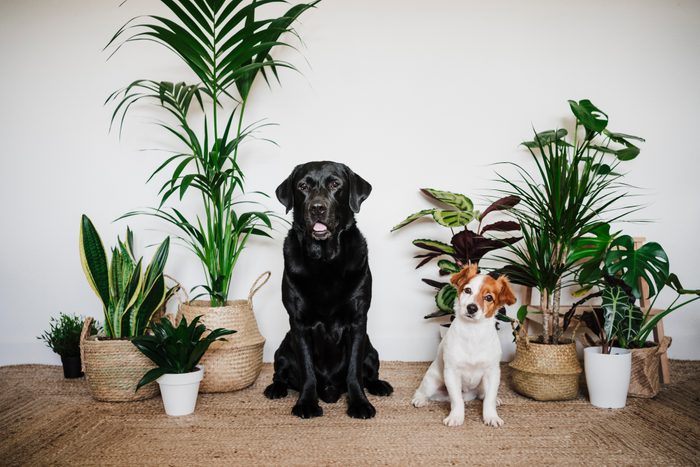Elephant’s ear
Alocasia
Toxic component: Insoluble calcium oxalates
Alocasia—also known as elephant’s ear—is a striking dark green plant with large leaves, ideal for sprucing up indoor spaces. But like the dumb cane, it contains glass-like insoluble calcium oxalate crystals that can cause severe irritation both internally and externally, according to the Pet Poison Hotline. If your dog consumes it, you’ll need to make an immediate visit to your vet to monitor and treat symptoms. Should the plant irritate your dog’s skin or eyes, give your pup a bath and/or flush its skin and eyes with water.
Swap it: The low-maintenance calathea pinstripe lends a similar tropical aesthetic but is completely safe for your pup. As an added bonus, it’s also an air-purifying plant, releasing oxygen and detoxifying your home.
Liudmyla Liudmyla/Getty Images
Citrus plants and peels
Rutaceae family
Toxic components: Essential oils and psoralens
“Many [citrus] plants that produce edible fruit—including grapefruit, oranges and lemons—are toxic if the actual plant portion is ingested,” says Dr. Zacharias. “For example, the skin of the fruit, the leaves or the stems can often be dangerous.”
Whether you grow these plants in your yard or decorate with indoor fruit trees, keep them away from your dog. As for citrus fruits, store them out of reach of pets—like in a drawer or container in the fridge. And safely discard your peels to ensure a nosy dog can’t dig them out of the trash.
How will you know if your pup has been munching on citrus plants? Reactions may not be as severe as with other poisonous plants for dogs (it can cause skin inflammation), but if you suspect your four-legged friend has nibbled on one, call your vet for guidance. The doctor may request that you bring your dog in, especially if severe symptoms, such as vomiting or diarrhea, occur.
Swap it: Dog owners can do their pets a favor by trading citrus plants for hanging plants that are well out of reach of curious pets. If you miss the height of taller indoor citrus trees, try the Musa Dwarf Cavendish banana tree, which is both safe for dogs and a fruit producer.
Oleander
Nerium oleander
Toxic component: Cardiac glycosides
Oleander, known for its white or pink flowers and height that provides privacy between yards, is another poisonous plant for dogs. (And humans, for that matter.)
“Oleander ingestion causes extreme salivation, abdominal pain, vomiting, diarrhea and lethargy. In severe cases, it causes liver failure and death, and it can ultimately interfere with the heart’s ability to beat properly,” explains Dr. Long. “Once it is known that the dog ingested these poisonous leaves, rapid transfer to a veterinary hospital where vomiting can be induced is key. Supportive therapy with drugs designed to control gastrointestinal signs, as well as reverse liver and heart issues, is key to survival.”
Swap it: People plant oleander for vibrant, lush outdoor foliage. For something similar, try a crepe myrtle tree instead. Worried about not having the greenest thumb? Don’t worry—it’s possible to bring a dead plant back to life.









































